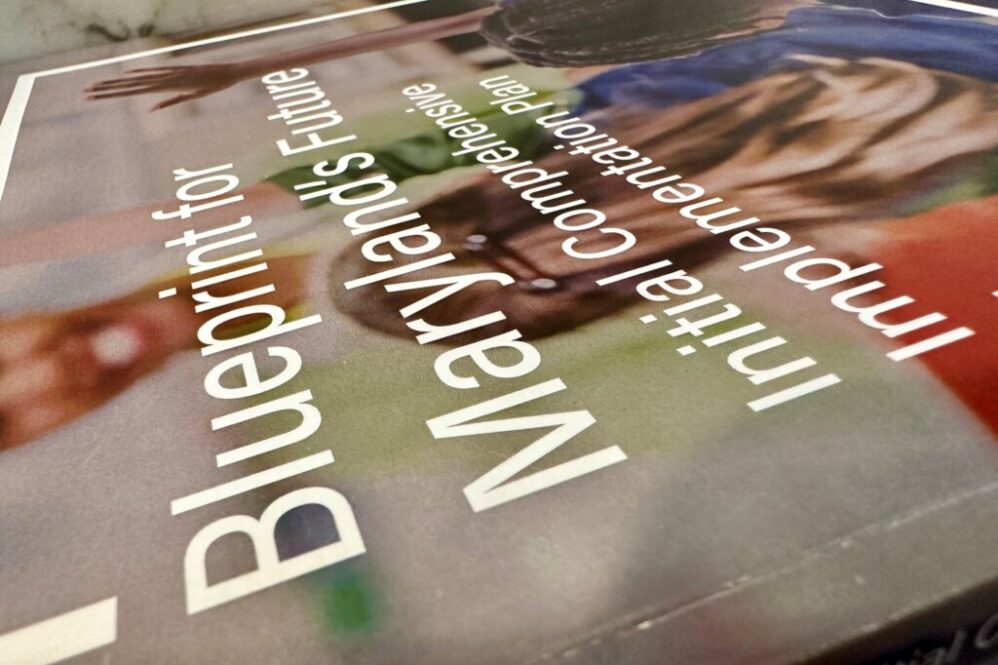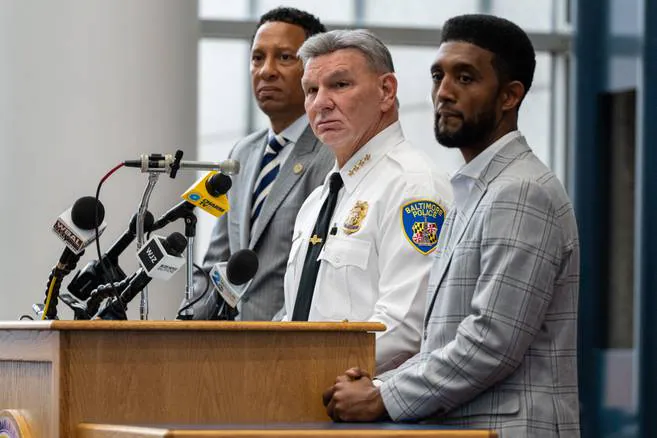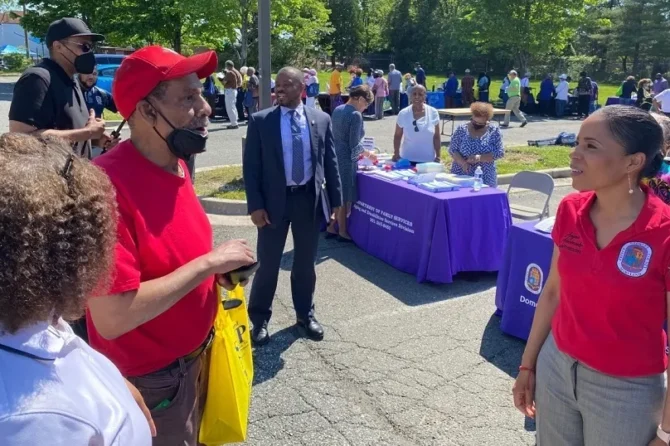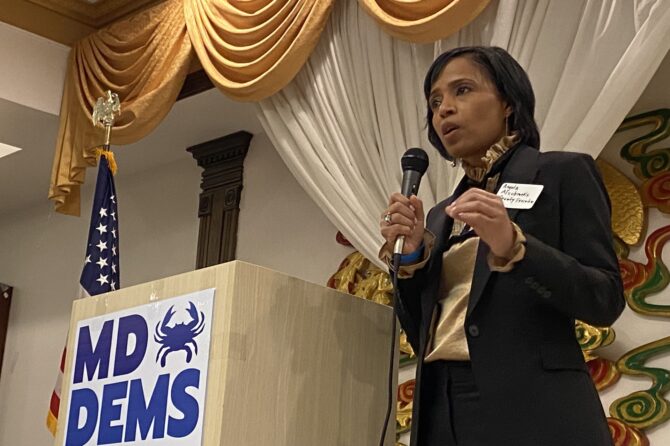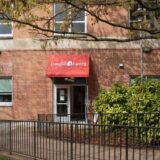MARYLAND MATTERS: Maryland’s local school systems submitted their plans to implement a decade-long education reform plan, the Blueprint for Maryland’s Future, earlier this month. And now they must start the work of putting the plans into action — or risk state funding being withheld.
The Blueprint’s Accountability and Implementation Board, which is tasked with oversight of the sweeping multi-billion-dollar reforms, will determine in the next several weeks whether each school system’s initial report met minimum requirements.
Rachel Hise, executive director of the implementation board, said during a virtual meeting earlier this month that one of the most basic reviews will be whether each public school system in the state sufficiently answered more than 150 questions meant to guide implementation of reforms.
If the accountability board finds a local plan insufficient, it has the power to withhold 25% of Blueprint funding until minimum guidelines are met.
The initial implementation reports will guide local Blueprint goals through the 2023-24 school year based on four priorities: improve early childhood education, hire and retain high-quality and diverse teachers, make sure students are prepared for college and technical careers and offer more resources for students in need.
Currently, every school district plan notes that help is needed to recruit, hire and retain teachers in all levels of special education, that there’s a lack of certified or qualified teacher applicants and a limited number of college graduates entering the teaching profession.
The General Assembly is considering a bill, the Maryland Educator Shortage Act, which could help. The bill, which passed the House of Delegates earlier this month, would increase financial assistance programs for teachers and mental health professionals in schools and encourage diversification of the state’s public school workforce.
If also approved by the Senate and then signed into law by Gov. Wes Moore (D), who introduced the measure, the bill would go into effect July 1.
Del Stephanie Smith (D-Baltimore City), chair of the Legislative Black Caucus of Maryland’s education committee, wants to let teachers know with passage of the teacher’s shortage act that “help is on the way.”
Smith, who also chairs the Education & Economic Development Subcommittee of the Appropriations Committee, urges leaders at all 24 school districts to reach out to the state’s four historically Black colleges and universities and other minority serving institutions to find future teachers.
“We have colleges that cover a breadth of expertise, a breadth of geography and a breadth of different experiences,” she said Wednesday. “I would call on every local education agency to ensure they’re reaching out to all of these institutions.”
What school districts say they’re facing
One of the many questions school districts addressed in the first implementation report focuses on “hiring trends and needs.”
It asked: In what grade levels and subject areas has the school system struggled to recruit prospective teachers?
Here’s part of the documented responses from each county and Baltimore City:
Allegany – “FSU (Frostburg State University) is experiencing a decrease in enrollment of local students (Allegany County or surrounding areas). This trend has created a body of interns that attend FSU and intern in our buildings and then elect to return to the area from which they hail. This leaves us with fewer applicants to fill openings. For example, in 2022, we had six secondary math vacancies and only six candidates. This candidate pool, and others, is much smaller than what ACPS have experienced in the past, limiting our system’s opportunity to select a candidate that matches the needs of the position and the school.”
Anne Arundel – “From an analysis of our recent data, we are having challenges filling intermediate elementary grade positions, specifically 4th and 5th. When given an option, teachers prefer younger grade levels and if they are not able to teach in these levels, they often will go to a surrounding district where are primary grade vacancies. AACPS has needs spanning all content areas, including over 50 in special and elementary education.”
Baltimore City – “Historically, our greatest needs have been recruiting the requisite number of teachers in the harder-to-fill content areas of Career and Technical Education (CTE), English as a Second Language (ESOL), math, science, special education and world languages. This is in part because of the relatively low numbers of students in colleges of education that are electing to become certified in these harder-to-fill content areas. Although our college and university partners are working to increase the number of students in high-needs content areas, currently the majority of City Schools’ student interns are becoming certified in elementary, English, and social studies. Furthermore, CTE teachers often have significant industry experience, and depending on the vocation, the salaries that they can earn in their industries exceed what they will earn as CTE teachers. These content areas will continue to be a recruitment challenge in hiring for [next school year].”
Baltimore County – “Baltimore County Public Schools has historically had challenges with recruiting and hiring teachers in the critical need areas to include special education, mathematics, science, technology education, world languages (Spanish), and English Speakers of Other Languages (ESOL). Recently, Baltimore County Public Schools has added elementary education, early childhood, English, and social studies to the critical need areas. Hiring at all levels has been a challenge; however, the challenges are more prevalent at the middle school level. Each year, BCPS has hired more conditionally certified teachers in these critical shortage areas. In addition, there has been a national decline in the number of teacher candidates enrolled and graduating from teacher education programs.”
Calvert – “Hiring data from previous years has demonstrated that Calvert County Public Schools has had a difficult time hiring teachers in certain subject areas. These areas include the secondary education areas of math and science, as well as all grade levels in special education, as evidenced by vacancy data and timeline data for hiring in these areas. An additional challenge for Calvert County is the geographic location and limited housing options for single employees. Although less than an hour from Washington, D.C., and Annapolis, Calvert County is predominantly rural, with few options for rental housing and entertainment for recent college graduates. The county is considered a great place to raise a family but has less appeal for young professionals.”
Caroline – “Recruitment challenges stem from a number of challenges, including supply of teacher candidates, competition from other areas, as well as certification requirements. CCPS competes with mostly the other nine Eastern Shore counties for candidates, and the number of local teacher candidates is continuing to decrease while our demand increases. While currently CCPS ranks 3rd on the shore in terms of starting salary, we have traditionally been lower in that comparison which is a disadvantage to recruitment efforts. Furthermore, when certified teaching candidates cannot be found, conditional candidates must be hired in order to fill the positions and staff our schools.”
Carroll – “The supply of teachers continues to be a significant concern for CCPS, as data show that the number of individuals selecting teaching as a profession continues to decline. In addition, Maryland institutions of higher education continue to produce relatively few graduates in relation to the state’s need. Vacancies in critical shortage content areas combined with a shortage of local candidates and in-state programs that lead to teacher certification in those areas results in an emphasis on out-of-state recruiting efforts to help fill those vacancies in CCPS. The national teacher shortage continues to make it difficult to recruit highly qualified applicants in critical shortage content areas. An analysis of the CCPS candidate pool revealed that nearly 75% of the applicants were seeking positions in non-critical shortage content areas.”
Cecil – “Decreased enrollment in education programs has resulted in fewer candidates for vacancies. As the Cecil County Public Schools workforce ages out, CCPS will continue to face the challenge of hiring certified candidates. This has increased the number of conditional candidates being hired, specifically in the areas below.
- “Special Education, all grade levels: Each year CCPS hires dual certified candidates to fill vacancies. As general education [content] positions open within the system, teachers will transfer to those positions creating a cycle of unfilled special education positions each year. Increasing caseloads and workloads contribute to people leaving special education more quickly.
- 6-12 Math: CCPS continues to struggle with attracting graduates with mathematics degrees into the field of education as there are other career opportunities available with higher salaries and fringe benefits. CCPS continues to seek career changers and support their certification work.”
Charles – “Diverse representation in education throughout the State of Maryland and across the nation remains a challenge. Still, CCPS progressed in increasing representation, surpassing the state. For example, CCPS has increased the overall number of diverse professional staff by 8.5% over the past five years, outpacing the state by 5.71%. Fortunately, the proximity of the Washington, D.C. metro area and recruitment outreach to Historically Black Colleges and Universities (HBCUs), Minority Serving Institutions (MSIs), Hispanic Serving Institutions (HSIs) allow access to diverse staff candidates despite the shrinkage in the teacher pipeline across the US. The CCPS Board of Education will continue to charge the Office of Human Resources through the Superintendent with strategic diversity hiring practices. The school system will also continue to evaluate Title II data to target universities and job fairs for recruitment of diverse candidates.”
Dorchester – “Dorchester County Public Schools (DCPS) has an extremely high turnover rate. DCPS had an attrition rate of 18% for the (2021-22) school year. Historically, DCPS has not been able to fill most certified teaching vacancies. DCPS has drafted a Recruiting Plan for the current school year. The plan specifies recruitment fairs targeting critical needs areas. A heightened focus will be on HBCUs to recruit a more diverse population that more closely matches our student demographics. Reassessing our recruitment teams is also a process that we are revisiting. DCPS also looks to recruit Special Education teacher candidates from colleges and universities with solid reputations for producing quality Special Education teachers, such as Bloomsburg University [in Pennsylvania] and the University of Maryland Eastern Shore.”
Frederick – “Of the teachers employed during the 2021-2022 reporting period [approximately] 170, or 39%, were hired to teach in critical shortage areas. These critical shortage areas, as defined by the Maryland State Department of Education (MSDE), now include all content areas. Previously, the critical shortage areas included special education, science, mathematics, STEM, Career and Technical Education (CTE), and English learners (EL). Our special education and EL positions throughout all grade levels presented an area of struggle in recruiting qualified candidates for these positions. Science, mathematics, STEM, and CTE positions are more relevant in our secondary areas and present a struggle in securing candidates to fill these vacant positions.”
Garrett – “Garrett County Public Schools (GCPS) has traditionally had a strong pool of teacher candidates in all certificate areas to consider for open positions. Over the last several years, we have had fewer applicants for all positions, which has created a challenge to ensure we have the most highly qualified educators to fill classroom positions. As a result, we are hiring more conditional teachers and spending much more time, money, and effort to recruit available certified teachers. In addition, to compete with other local education agencies, we also have to hire much earlier than in the past. Another strategy that GCPS has implemented due to this shortage has been the creation of several Grow Your Own initiatives to try to build a pipeline of educators within our school system. Another challenge in recruiting teachers to GCPS is the lack of affordable housing and the availability of jobs for a spouse in another professional position.”
Harford – “We are directly impacted by the lack of educators coming from Maryland Institutes of Higher Education (MIE). As an example, only 157 teachers hired came to HCPS from a Maryland IHE out of the 281 teachers hired during the 2021-2022 MSDE reporting year. When we do not have enough certified educators to fulfil our needs, we are having to use creative measures to fill our classroom vacancies. Those include misassigning teachers outside of their field, hiring conditional teachers, and spending much more time, money, and effort to recruit certified teachers that are available. In order to compete with other local education agencies, we are also having to hire much earlier than in the past. We are hiring students while they are early in their internship year, which does not allow us to fully evaluate their skillset and fit for our students.”
Howard – “At this time, Maryland does not have a comprehensive statewide package to attract out-of-state educators to move to the state. HCPSS is competing with other states that offer educators benefits such as free tuition if they teach in the state for a certain number of years. For individuals who are hired on a conditional certificate, many are finding it challenging to pass the various praxis tests and find it challenging to work full time and gain the credits needed to be certified. To quantify this problem for HCPSS, during the 2022 reporting period, 144 conditionally certified teachers were hired. That number was 81 in 2021 and averaged 42 from 2018-2020. By the beginning of the 2022-23 school year, approximately one-third of the teachers hired with a conditional certificate during the previous four years had separated from employment with HCPSS.”
Kent – “Over the past seven years, teacher turnover has been the highest at the Secondary Level (grades 7-12). More specifically, the areas of special education, math, and science have been the hardest areas to retain high quality and diverse teachers. There are challenges associated with hiring and retaining high quality special education teachers. Special education teachers report challenges such as the amount of paperwork that is involved on a daily basis, taking away from effective co-planning time and leading to a lot of work being taken home, which contributes to teacher burnout. Over the past five years, KCPS has had multiple secondary special education vacancies each year.”
Montgomery – “The challenges associated with recruiting teachers in these areas are decreased enrollment in schools of education; increase in teachers retirements or separation to pursue other opportunities; increase in demand for teachers, nationally; and an increase in compensation and incentives, nationally. These factors have created a teacher shortage and a teacher’s market where teachers across all areas of certifications have many opportunities to pursue a career in education closer to their desired area.”
Prince George’s – The challenges for hiring teachers…are declining enrollment in Early Childhood and Elementary Teacher Education programs, both locally and nationally; capabilities of interested candidates to successfully complete MSDE certification requirements and/or pay for additional required courses needed to earn certification; the requirements of the state to hold dual certification (Special Education & Early Childhood) for teachers in the Early Childhood Centers; lack of teacher candidates due to decline in individuals enrolling in teacher preparation programs in higher education and in alternative preparation programs; recruiting and retaining enough eligible candidates with certification and experience in ESOL and Special Education; recruiting and retaining diverse teachers, particularly Hispanic/Latino, and male teacher candidates; cost of living in Maryland compared to surrounding localities such as Virginia and the District of Columbia.”
Queen Anne’s – “Historically, Secondary Science, Math, and World Languages have been the most critical areas and the hardest to find with fewer students entering these fields of study. With the current teacher shortage, we are now finding Special Education, Elementary, and Secondary positions in all levels are increasingly harder to recruit. The challenges associated with hiring in these areas stems from the decreased enrollment in teacher preparation programs at colleges and universities nationwide.”
St. Mary’s – “There are many factors that impact our ability to recruit prospective teachers. One of the major factors is our location. St. Mary’s County is rural and lacks any major attractions that would encourage recent graduates to begin their careers here. The median household income in 2021 was $102,859 (see census link), which is well above the starting salary of a teacher, making it difficult for single, recent graduates. Because of this high income, apartments and rentals are scarce and expensive. The average apartment price is $1,000 – $1,200, which is almost half of a new teachers monthly bring-home pay. Pax River Naval Air Station (NAVAIR) is our largest competitor. Often, teachers are attracted to government jobs and higher salaries that the government and its contractors can offer.”
Somerset – “The School System has struggled to hire and retain Art, World Language, Special Education, Secondary Math and Secondary English teachers. Challenges are lack of candidates specializing in these certification areas as well as the lack of area colleges graduating teacher candidates with these credentials.”
Talbot – “Until recently, TCPS has had success in ensuring that certified teachers each of our classrooms regardless of grade-level or content area. Historically the greatest challenge in securing qualified teachers has been in special education and secondary mathematics. The high demand for teachers in these two areas has impacted the number of qualified candidates available and lower salaries on the Eastern Shore has made it difficult to compete for candidates with higher paying districts. TCPS has engaged contractual special education positions when needed to secure adequate staffing or has maintained unfilled positions that would otherwise have allowed us to improve services. In secondary math, schedules have been combined to accommodate vacant math positions. TCPS has seen its greatest shortage of teachers in the 2022-2023 school year. Eight positions remain unfilled [with] two in special education, one ESOL, two high school math, two high school English, and one elementary position.”
Washington – “WCPS predicts we will continue to have vacancy needs, particularly in grade and subject areas in which industries requiring comparable skills (for example: math, science, foreign language, speech language pathologists) are more appealing due to benefits, compensation, and work environment and expectations.”
Two of the four challenges in the county schools include: “An increase in the number of students diagnosed with disabilities that qualify for special education. WCPS is seeing increases in autism diagnoses, impacts of the opioid crisis, and extreme behaviors due to environmental factors. Qualified staff, as well as college students, are reluctant to pursue careers in special education due to the increased needs, risks (injury), and increased litigious nature of special education,” and “6% of current WCPS teachers are eligible for retirement within the next three years.”
Wicomico – “The school system has struggled to recruit and hire secondary math, science, early childhood, and special education teachers. The challenges for hiring teachers in these areas are higher teacher turnover, extra course requirements for certification, and competitive salaries for other careers, particularly in math and science. Middle school positions are exceptionally difficult to fill. In the past two years, staff who left our district stated the top reasons for leaving were: #1 Family/personal reasons (41%), #2 Retirement (27%), and #3 Work/life balance (26%). While the role of a teacher has always been challenging, students are now further behind following the COVID pandemic, making the perception of the difficulties of teaching more pronounced. Combining this with the negative portrayal of the teaching profession through media sources, we are finding fewer candidates at hiring fairs as well as those graduating with degrees in education.”
Worcester – “When analyzing recent data and projecting future openings, it appears that Early Childhood and Elementary teachers will be the greatest need of the school district. Special Education teachers at all levels will also be a targeted area of recruitment. WCPS has drafted a Recruiting Plan for the current school year. The plan specifies recruitment fairs targeting critical needs areas. WCPS has been successful over the past four years with its own Teacher Recruitment Fair recruiting and hiring both novice and veteran teachers from around the Maryland, Delaware, and Virginia regions. This recruitment fair is intentionally scheduled for the second Saturday each March to get an early start over other school districts in our region.”
What’s next
The Blueprint documents turned in this month represent the first of three required implementation reports. The state Department of Education will review each plan and offer recommendations to the Blueprint board, which could make formal approvals on school system plans in May and June.
School officials must submit a second set of Blueprint plans due in March 2024 to highlight the four priorities through the 2026-27 school year.
A third and final submission would be due in 2027 to cover the school years between 2027-28 and 2031-32. State legislation requires that the Blueprint board, which will remain operative until fiscal year 2032, to approve any changes to the overall plan every year by Aug. 1.
Photo: The Blueprint for Maryland’s Future education reforms will add billions of dollars in state funding annually for public schools within 10 years. Photo by Danielle E. Gaines.


